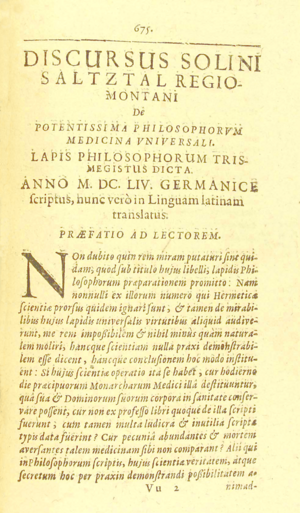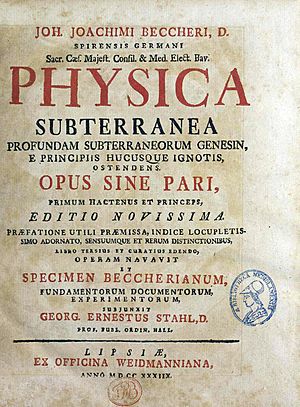Johann Joachim Becher facts for kids
Quick facts for kids
Johann Becher
|
|
|---|---|
 |
|
| Born | 6 May 1635 |
| Died | October 1682 (aged 47) |
| Known for | Phlogiston theory |
| Scientific career | |
| Fields | Chemistry, alchemy |
| Influenced | Georg Ernst Stahl |
Johann Joachim Becher (German: [ˈbɛçɐ]; 6 May 1635 – October 1682) was a German physician, alchemist, precursor of chemistry, scholar and adventurer, best known for his development of the phlogiston theory of combustion, and his advancement of Austrian cameralism.
Early life and education
Becher was born in Speyer during the Thirty Years War. His father was a Lutheran minister and died when Becher was a child. At the age of thirteen Becher found himself responsible not only for his own support but also for that of his mother and two brothers. He learned and practiced several small handicrafts, devoted his nights to study of the most miscellaneous description and earned a pittance by teaching.
In 1654, at the age of nineteen, he published the Discurs von der Großmächtigen Philosophischen Universal-Artzney / von den Philosophis genannt Lapis Philosophorum Trismegistus (discourse about the almighty philosophical and universal medicine by the philosopher called Lapis Philosophorum Trismegistus) under the pseudonym 'Solinus Salzthal of Regiomontus.' It was published in Latin in 1659 as Discursus Solini Saltztal Regiomontani De potentissima philosophorum medicina universali, lapis philosophorum trismegistus dicta (translated by Johannes Jacobus Heilmann) in vol. VI of the Theatrum Chemicum.
Career
In 1657, he was appointed professor of medicine at the University of Mainz and physician to the archbishop-elector. His Metallurgia was published in 1660; and the next year appeared his Character pro notitia linguarum universali, in which he gives 10,000 words for use as a universal language. In 1663, he published his Oedipum Chemicum and a book on animals, plants and minerals (Thier- Kräuter- und Bergbuch).
In 1666, he was made councillor of commerce (German: Commerzienrat) at Vienna, where he had gained the powerful support of the prime minister of Emperor Leopold I. Sent by the emperor on a mission to the Netherlands, he wrote there in ten days his Methodus Didactica, which was followed by the Regeln der Christlichen Bundesgenossenschaft and the Politischer Discurs von den eigentlichen Ursachen des Auf- und Abblühens der Städte, Länder und Republiken. In 1669, he published his Physica subterranea; the same year, he was engaged with the count of Hanau in a scheme to acquire Dutch colonization of Guiana from the Dutch West India Company.
Meanwhile, he had been appointed physician to the elector of Bavaria; but in 1670 he was again in Vienna advising on the establishment of a silk factory and propounding schemes for a great company to trade with the Low Countries and for a canal to unite the Rhine and Danube.
In 1678, he crossed to England. He travelled to Scotland where he visited the mines at the request of Prince Rupert. He afterwards travelled for the same purpose to Cornwall, and spent a year there. At the beginning of 1680, he presented a paper to the Royal Society in which he attempted to deprive Christiaan Huygens of the honour of applying the pendulum to the measurement of time. In 1682, he returned to London, where he wrote Närrische Weisheit und weise Narrheit (in which, according to Otto Mayr he made extensive references to temperature regulated furnaces), a book the Chymischer Glücks-Hafen, Oder Grosse Chymische Concordantz Und Collection, Von funffzehen hundert Chymischen Processen and died in October of the same year.
Legacy
Austrian Cameralist
Becher was the most original and influential theorist of Austrian cameralism. He sought to balance between the need to reinstate postwar levels of population and production both in the countryside and the towns. By leaning more seriously on trade and commerce, Austrian cameralism helped to transfer attention to the troubles of the monarchy's urban economies. Ferdinand II had already taken some corrective steps before he died by attempting to ease the debts of the Bohemian towns and to put limits on some of the land-holding nobility's commercial rights. Even though preceding Habsburgs had held the guilds responsible for their restrictiveness, wastefulness, and the poor value of the merchandise they created, Ferdinand II ramped up the pressure by extending rights to private artisans who usually then earned the fortification of powerful local leaders such as seigneurs, military commanders, churches, and universities. An edict by Leopold I in 1689 had granted the government the right to monitor and control the number of masters and cut down on the monopoly effect of guild operations. Even previous to this, Becher, who was against all forms of monopoly, surmised that a third of the Austrian lands’ 150,000 artisans were "Schwarzarbeiter" who were not in a guild.
Chemist and alchemist
William Cullen considered Becher as a chemist of first importance and Physica Subterranea as the most considerable of Bechers writings.
See also
 In Spanish: Johann Joachim Becher para niños
In Spanish: Johann Joachim Becher para niños



